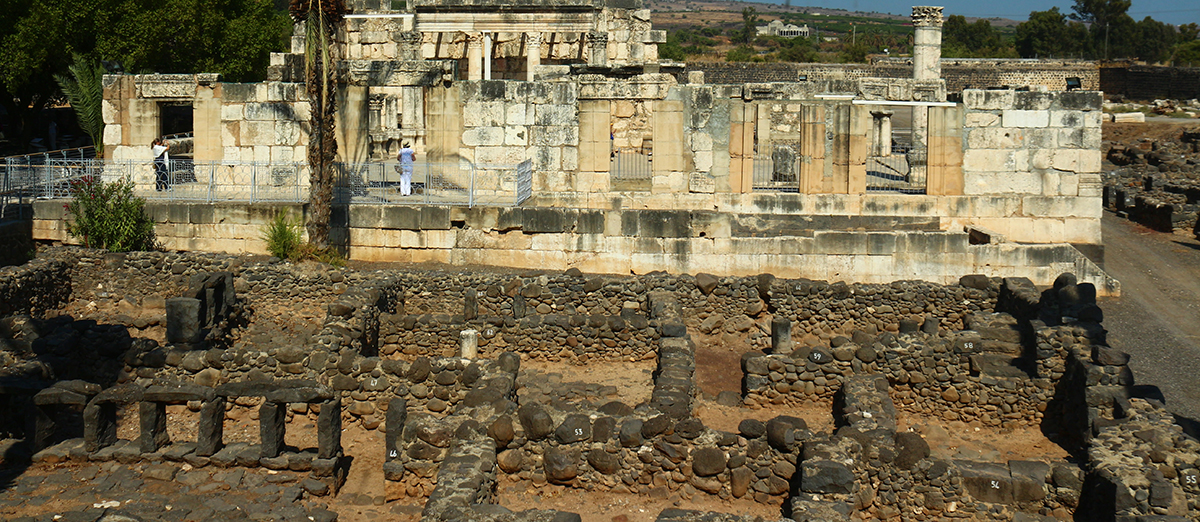

by Trent and Rebekah Dutton
Synopsis: Though only a small fisherman's village, Capernaum provided a temporary home to that Rabbi who changed the course of human history.
When you think of cities, towns, and other locations that have left their mark on human history, particularly in the context of Scripture, Capernaum is not usually one of them. Jerusalem is undoubtedly on the list, but it would most likely take a moment to think… "Jesus, life of Jesus, Capernaum." Capernaum is seemingly an unlikely spot to serve as a pivot point of history, but when its location, background, and archaeology are considered, it begins to make sense.
Geographically situated on the north shore of the Sea of Galilee, Capernaum rests at a crossroads of the ancient world. In this region, the Jezreel and Jordan Rift valleys concentrate traffic in the area. If traveling to any areas such as Anatolia (modern-day Turkey), Syria, Mesopotamia, Egypt, or the African continent, one would most likely cross in or near this area.
Historically, the biblical text identifies Capernaum as the village where the Messiah spent a significant amount of His early ministry. Next to Jerusalem, Capernaum is one of the most frequently mentioned places where Jesus operated. Concerning its establishment, Capernaum and its toponyms (ancient place-names) do not appear in the Old Testament or other ancient texts before the Exilic Period. Hellenistic influences via Greek expansion, coupled with later Roman influence, resulted in solidified roads in the area, including a branch of the Via Maris that ran through the village. This is evident in a Roman milestone at Capernaum, marking and commemorating improvements to the already existing Via Maris caravan highway (OEBA, 173). Combine this with spring water inlets to the sea that created a rich fishing environment, and it made for a community that could support a modest village population and outpost for monitoring the highway. This historical setting provided the stage for Jesus's early ministry, which included a tax collector becoming a disciple and crowds to witness a paralytic being healed. As a result of Capernaum's population and the surrounding road network, such news would quickly spread to the surrounding region.
Archaeologically, Capernaum is an interesting site, but not for the reasons that small biblical villages normally are. Old Testament or New, smaller villages and settlements typically provide an insight into the material culture and economy of the area, as it relates to the larger cities they surround. In turn, this often provides the human context for textual sources, giving a fuller picture of the historical reality. Capernaum does that but in a unique way. In and around Capernaum, there are multiple sites on the traditional Christian pilgrimage trail. Both Byzantine and modern Christians flocked to places such as Peter's house and the Tabgha (the traditional site of one of the loaves and fishes miracles, down the shoreline from Capernaum). However, what many admire, walk in, on, and around, but do not understand, is the ancient synagogue in Capernaum—or, rather, that there are three of them superimposed. From the top down, the white limestone synagogue dates to the fifth and sixth centuries. Next is a combination of basalt and limestone, dating to the fourth century. The last synagogue layer is a basalt structure from the first century (OEBA, 174). This lowest basalt synagogue would likely be the one mentioned in passages such as Mark 1:21, when Jesus enters the synagogue in Capernaum. This structure helps to tell an archaeological story that is often so hard for our eyes to see. Often, in "dirt" archaeology, or archaeological contexts where superimposed structures are uncovered, the process of destruction and rebuilding can be difficult to reconstruct. However, in this instance, the photo showing the side profile of the synagogue provides a clear distinction between the structures, that is, well, black and white.
On your next visit to Israel, when you disembark the tour bus at Capernaum, make your way to the synagogue. Certainly take in the surrounding items: the well-preserved first-century street plan that runs through the village or the modern church (colloquially referred to as "The Spaceship") built over the traditional site of Peter's house. However, do not let these distract you and miss the foundations of the first-century synagogue where the initial teachings of the gospel were proclaimed to the world.
OEBA = Master, Daniel M., ed. The Oxford Encyclopedia of the Bible and Archaeology. Volume 1. USA: Oxford University Press, 2013.
Author Bio: Trent and Rebekah Dutton both hold Master's degrees in Biblical Archaeology from Wheaton College, in the Chicago, IL area. They have participated in four full excavation seasons with The Leon Levy Expedition to Ashkelon, two seasons at Tel Shimron in the Jezreel Valley, and one season at Tel Burna in the Shephelah. They can be reached at trentdutton@gmail.com.

Image 1: Capernaum 5th and 6th-century white limestone synagogue behind 1st-century village foundations.

Image 2: 5th and 6th-century white limestone synagogue columns.

Image 3: Black basalt 1st and 4th-century synagogue foundations under later white limestone synagogue.
